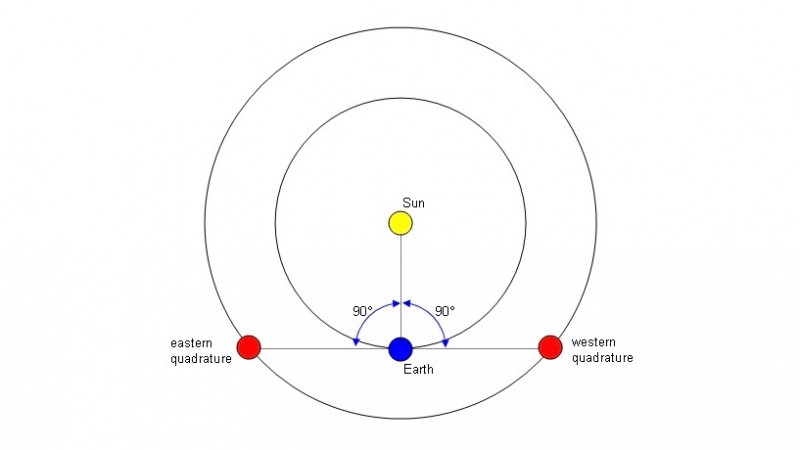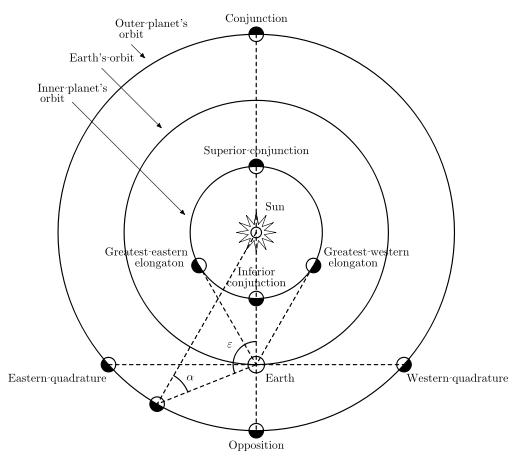
If you could look down on the solar system plane from above on May 21, 2021, you’d see that the sun, Earth and Jupiter form a 90-degree angle in space, with our planet Earth at the vertex (the meeting point of the angle’s 2 sides). Astronomers say that – at this point in our mutual orbits around the sun – Jupiter is at west quadrature. In other words, it’s 90 degrees west of the sun in our sky, high in our sky at sunrise.
Incidentally, the moon reaches west quadrature (90 degrees west of the sun) once each month, at its last quarter phase. Earlier this month, the moon and Saturn – which is near Jupiter in the sky now – both reached west quadrature on the same date: May 3, 2021.

When the moon is at west quadrature – or 90 degrees west of the sun – we say the moon is at its last quarter phase. At such times, the moon soars to its highest point in the sky at about 6 a.m. local time (7 a.m. daylight saving time). Whereas the moon sweeps to west quadrature every month, Jupiter and Saturn only do so once a year.
Because Jupiter now lies 90 degrees west of the sun, Jupiter reaches its highest point in the sky approximately 6 hours before the sun does likewise at solar noon (midway between sunrise and sunset). Visit timeanddate.com and scroll to the bottom of the page to find out when Jupiter transits (climbs highest up for the day) in your sky.
Some three months from now – on August 20, 2021 – Jupiter will reach opposition. The king planet will then be opposite the sun in Earth’s sky, or 180 degrees from the sun. If you could look down on the solar system plane at that time, you would see the sun, Earth and Jupiter making a straight line in space. At opposition, a heavenly body climbs highest up in the sky at midnight. (By midnight, we mean midway between sunset and sunrise.)
Opposition and quadrature can happen only to solar system bodies that orbit the sun outside Earth’s orbit. Planets that orbit the sun inside Earth’s orbit (Mercury and Venus) can never reach opposition or quadrature. Instead, they always remain near the sun as seen from Earth. So we see them either in the east before sunrise, or in the west after sunset.

Jupiter’s quadratures and oppositions enabled the innovative astronomer Copernicus (1473-1543) to compute Jupiter’s distance from the sun. He did this by charting Jupiter’s (and the Earth’s) change of position from west quadrature to opposition, and from opposition to east quadrature (when the planet lies 90 degrees east of the sun). All the while, Copernicus presumed that Jupiter and Earth both orbit a central sun.
By using the astronomical unit – the Earth-sun distance – as his baseline, Copernicus relied upon the magic of geometry to figure out that Jupiter is over five times the Earth’s distance from the sun!
Want to know how Copernicus did it? See Solar System Scale: Copernicus’ Method at Spitz.com.
At west quadrature, Jupiter’s shadow points maximally westward of Jupiter in Earth’s sky. It’s at this time, as viewed through the telescope, that Jupiter’s four major moons – Io, Europa, Callisto and Ganymede – swing into Jupiter’s shadow to the west of Jupiter, and then pass behind the planet itself. Then, half an orbit later, the shadows of the moons transit (cross) Jupiter’s disk before the moons themselves do.
Find Jupiter’s Moons via Sky & Telescope

Some three months from now – at Jupiter’s opposition on August 20, 2021 – Jupiter’s shadow will point straight outward from Jupiter, neither slanting westward nor eastward of the king planet. Then, on November 15, 2021, Jupiter will swing to east quadrature – 90 degrees east of the sun – at which time Jupiter’s shadow will point maximally eastward of Jupiter. Jupiter’s moons will then travel through Jupiter’s shadow to the east of Jupiter.
Bottom line: Look for Jupiter – the brightest star-like object in the morning sky – at west quadrature, or 90 degrees west of the sun, on May 21, 2021. At eastern quadrature, Jupiter climbs highest in the sky around 6 a.m. (7 a.m. daylight saving time).











